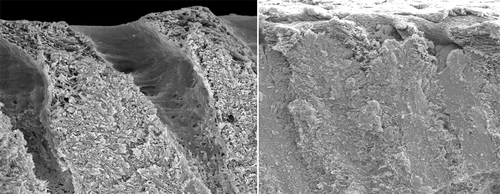Nature-inspired advance for treating sensitive teeth

Taking inspiration from Mother Nature, scientists are reporting an advance toward preventing the tooth sensitivity that affects millions of people around the world. Their report on development of the substance, similar to the adhesive that mussels use to attach to rocks and other surfaces in water, appears in the journal ACS Applied Materials & Interfaces.
Quan-Li Li, Chun Hung Chu and colleagues explain that about 3 out of every 4 people have teeth that are sensitive to hot, cold, sweet or sour foods and drinks. It occurs when the hard outer enamel layer on teeth and the softer underlying dentin wear away, stimulating the nerves inside. Some sugar-free gums and special toothpastes can help reduce that tooth hyper-sensitivity. However, Li and Chu cite the need for substances that rebuild both enamel and dentin at the same time. To meet that challenge, they turned to a sticky material similar to the adhesive that mussels use to adhere to surfaces. They reasoned that it could help keep minerals in contact with dentin long enough for the rebuilding process to occur.
They describe laboratory tests that involved bathing human teeth with worn-away enamel and dentin in liquid containing the sticky material and minerals. Teeth bathed in the sticky material and minerals reformed dentin and enamel. However, teeth bathed just in minerals reformed only enamel. The gooey substance "may be a simple universal technique to induce enamel and dentin remineralization simultaneously," they concluded.
The authors acknowledge funding from NSFC RGC grant, the Outstanding Youth Fund from the Board of Education of Anhui Province and the Youth Foundation of the Anhui Provincial Natural Science Foundation.
More information: Polydopamine-Induced Tooth Remineralization, ACS Appl. Mater. Interfaces, 2012, 4 (12), pp 6901–6910. DOI: 10.1021/am302041b
AbstractInspired by mussel bioadhesion in nature, dopamine is extensively used for biomaterial surface modification. In this study, we coated dopamine on demineralized enamel and dentin surfaces to evaluate the effect of polydopamine coating on dental remineralization. Dental slices containing enamel and dentin were first etched with 37% phosphoric acid for 2 min, followed by immersion in a 2 mg/mL freshly prepared solution of dopamine (10 mM Tris buffer, pH 8.5) for approximately 24 h at room temperature in the dark to obtain polydopamine coating. Then, the dental slices with and without polydopamine coating were immersed in the supersaturated solution of calcium and phosphate at 37 °C for 2 and 7 days. The supersaturated solution of calcium and phosphate was refreshed each day. The precipitates were characterized by SEM, XRD, FTIR, microhardness, and nanoscratch analyses. No significant difference was observed in the remineralization of enamel whether it was coated with polydopamine or not. However, a significant difference was found in dentin remineralization between dentin with and without polydopamine coating. Polydopamine coating remarkably promoted demineralized dentin remineralization, and all dentin tubules were occluded by densely packed hydroxyapatite crystals. Thus, coating polydopamine on dental tissue surface may be a simple universal technique to induce enamel and dentin remineralization simultaneously.
Journal information: ACS Applied Materials and Interfaces
Provided by American Chemical Society



















